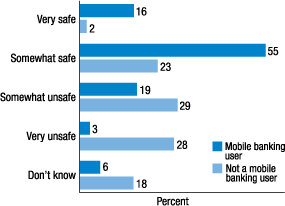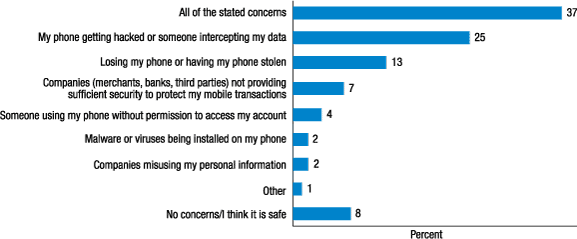Consumers and Mobile Financial Services
March 2016
- Mobile Security and Privacy
- Use of Mobile Phones in Financial Decisionmaking
- Conclusion
- Appendix A: Technical Appendix on Survey Methodology
Mobile Security and Privacy
Perceptions of Safety and Risks
One of the main reservations consumers have with adopting mobile banking and mobile payments is concern about the security of the technology. Despite the increasing prevalence of mobile banking and mobile payments, a significant share of consumers believe the technology to be unsafe or do not know how safe it is.
Among all mobile phone users, 24 percent believed that people's personal information is "somewhat unsafe" when using mobile banking, and 18 percent believed that it is "very unsafe." A further 15 percent of mobile phone users simply did not know how safe it is to use mobile banking. Only 8 percent said it was "very safe" to use mobile banking.
While the share of respondents with concerns is similar to previous years, there is a slight shift toward more reassurance about people's safety with mobile banking among consumers over the course of the last three Mobile Surveys: in 2015, 43 percent of mobile phone users said they believe people's personal information is either "very safe" or "somewhat safe," an increase from 40 percent in 2014 and 38 percent in 2013 (table 7).
When mobile phone users were asked how safe they believe people's personal financial information is when they use a mobile phone to pay for a purchase at a store, 27 percent said it was "somewhat unsafe" and 19 percent said it was "very unsafe." As with mobile banking, there exists significant uncertainty about the security of POS mobile payments, with 15 percent saying they "don't know" whether people's personal financial information is safe when making such a payment. The share of consumers who said that POS mobile payments are "very safe" was only 6 percent, while 32 percent said that it is "somewhat safe."
Table 7. How safe do you believe people's personal information is when they use mobile banking?
Percent, except as noted
| Response | 2013 | 2014 | 2015 |
|---|---|---|---|
| Very safe | 6 | 7 | 8 |
| Somewhat safe | 32 | 34 | 35 |
| Somewhat unsafe | 25 | 25 | 24 |
| Very unsafe | 18 | 19 | 18 |
| Don't know | 17 | 15 | 15 |
| Number of respondents | 2,341 | 2,603 | 2,244 |
Note: Among respondents with a mobile phone.
As with mobile banking, there has been a slight shift over time in perceptions of the safety of using a mobile phone to pay for a purchase in a store. In 2015, 38 percent of respondents said that using a mobile phone to pay for a purchase in a store is either "very safe" or "somewhat safe," an increase from 35 percent in 2014, and 33 percent in 2013 (table 8).17
Table 8. How safe do you believe people's personal information is when they use a mobile phone to pay for a purchase at a store?
Percent, except as noted
| Response | 2013 | 2014 | 2015 |
|---|---|---|---|
| Very safe | 4 | 5 | 6 |
| Somewhat safe | 30 | 30 | 32 |
| Somewhat unsafe | 27 | 28 | 27 |
| Very unsafe | 19 | 21 | 19 |
| Don't know | 18 | 15 | 15 |
| Number of respondents | 2,341 | 2,603 | 2,244 |
Note: Among respondents with a mobile phone.
Mobile banking users have more confidence and less uncertainty about the security of mobile banking transactions, compared to non-users. Among mobile phone owners with bank accounts, the majority of mobile banking users rated mobile banking as "very safe" (16 percent) or "somewhat safe" (55 percent) in maintaining their personal information. Only 6 percent of mobile banking users indicated that they "don't know" how safe mobile banking is at protecting their personal information. In contrast, non-users were less likely to rate the overall security of mobile banking as "very safe" (2 percent) or "somewhat safe" (23 percent). Eighteen percent of non-users indicated that they "don't know" how safe it is to use mobile banking (figure 9).

Note: Among respondents with a mobile phone and bank account, for those who used mobile banking (n=801) and those who did not use mobile banking (n=1, 343) in the past 12 months.
Mobile phone owners were asked which one aspect of security would cause them the most concern about using a mobile phone for financial transactions such as mobile banking or paying for a purchase in a store (figure 10).18 Some reported fears of the phone being hacked or data interception (25 percent), lost or stolen phones (13 percent), and companies not providing sufficient security to protect mobile transactions (7 percent). While other specific concerns were noted by smaller numbers of respondents, the most common response was that they were concerned with all of those security risks occurring (37 percent). Only 8 percent of those with mobile phones indicated that they had no concerns about the security of mobile financial transactions.
Figure 10. Which one of the following security aspects are you most concerned with?

Security Behaviors and Information Sharing
Consumers appear to be cognizant of the need to protect the personal information stored on, and transmitted with, their phones. Seventy percent of smartphone owners reported that they password-protect their phone--in line with the 69 percent in 2014, and up from 61 percent in 2013 and 54 percent in 2012.19
In the 2015 Mobile Survey, smartphone owners were also asked a new question about other specific actions they may have taken with their smartphone that affect mobile security and privacy.20 Eighty-four percent of smartphone owners installed or updated their mobile operating system or apps, and 58 percent customized privacy settings, such as restricting which apps can track their location. Forty-three percent changed the password on their phone or apps, and 39 percent password-protected apps that store sensitive data. Thirty-three percent used anti-malware software or apps or other means to protect their smartphone, and 33 percent used an app or service that allows them to locate, remotely access, erase, or disable the phone in cases of loss or theft.
For the two actions on the list that increase mobile security risks, responses from smartphone owners also suggested that they avoid potential risks: 78 percent did not download or install apps from sources outside the primary app store for their phone, and 76 percent did not send or access sensitive data over public WiFi networks.
The sizable share of smartphone users who have restricted privacy settings on their phone is consistent with the preferences this group expressed about sharing their location. Smartphone users were asked about their level of agreement with the statement "I am willing to allow my mobile phone to provide my location to companies I shop with regularly so that they can offer me discounts, promotions, or services based on where I am." There appears to be significant discomfort with providing one's location to companies, as 33 percent indicated that they "disagree" and 26 percent "strongly disagree" (figure 11).

When smartphone owners were asked about their level of agreement with the statement "I am willing to answer security questions or provide additional information to my bank or credit union when I log into mobile banking so that my bank can enhance the security of my mobile transaction," the response pattern was quite different. In this case, the majority agreed--32 percent indicated they "strongly agree" and 42 percent that they "agree." Thirteen percent said they "disagree" and 12 percent indicated they "strongly disagree."
References
17. Due to rounding differences, the figure in the text for 2013 differs slightly from the sum of elements of table 8 for that year. Return to text
18. For the first time, the 2015 Mobile Survey asked all mobile phone users about their security concerns, regardless of whether the respondent had used their phone for mobile banking or mobile payments in the past year. In the past, similar questions were only asked of those who said that security concerns were a reason they had not adopted mobile banking or mobile payments. Return to text
19. At least one major mobile phone operating system has changed its default settings to require users to set a password unless they opt out. This change in default setting could also increase the incidence of password protection. Return to text
20. Questions about password protection and specific actions taken to enhance security were only posed to respondents with smartphones. Feature phone users are likely to use their phones for a more limited set of tasks, and may not have given as much thought to potential security risks given the more limited functionality of these types of phones. Also, feature phones may not have password protection or other security options. Return to text
